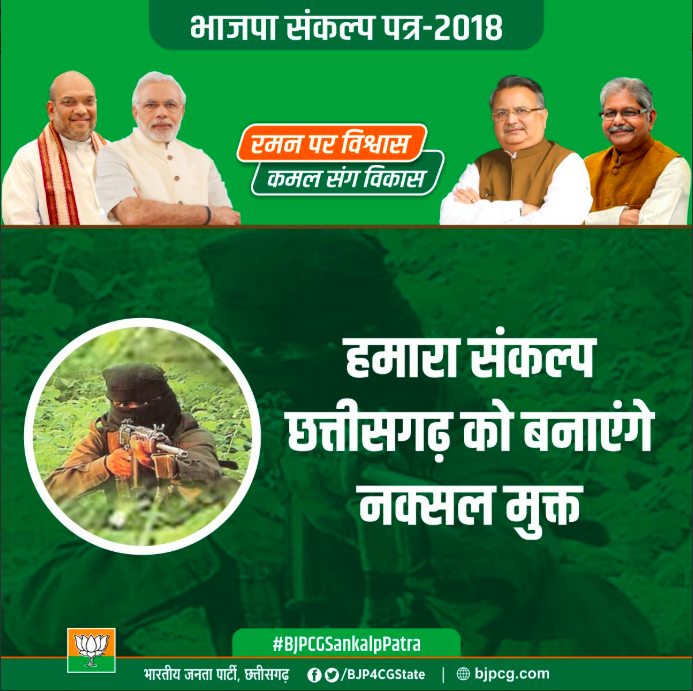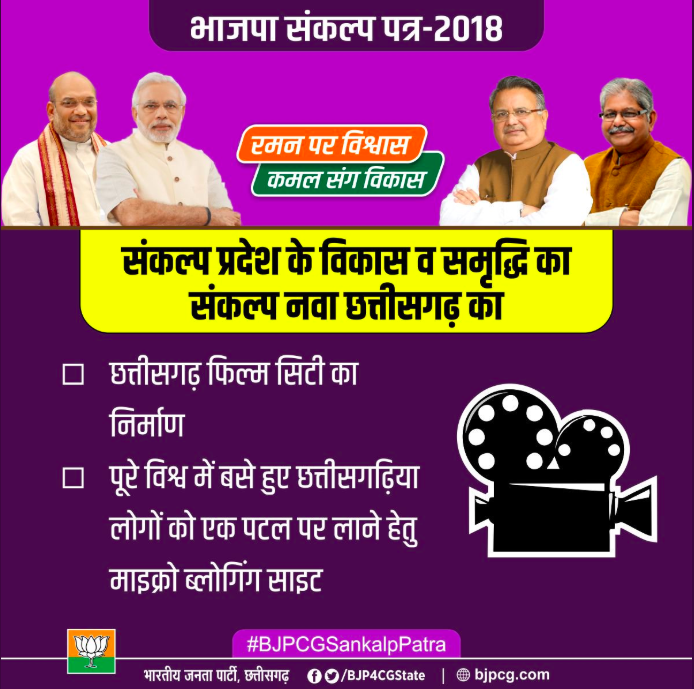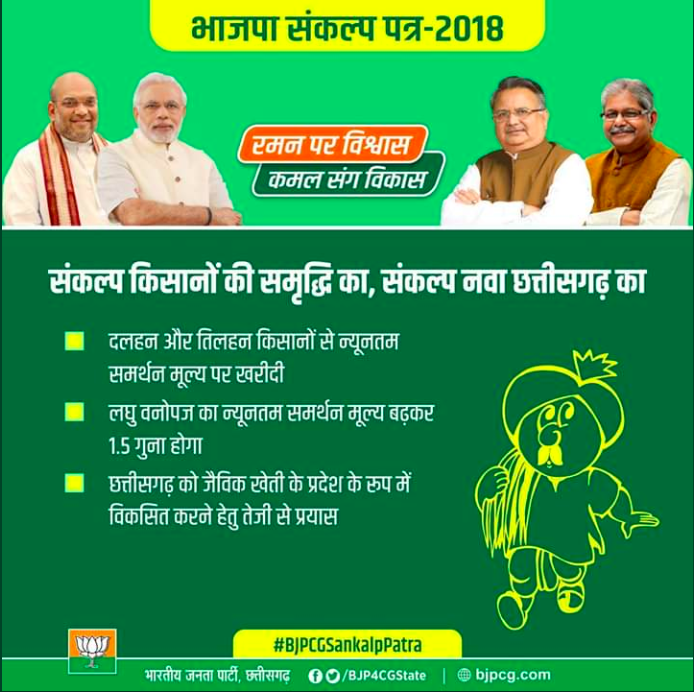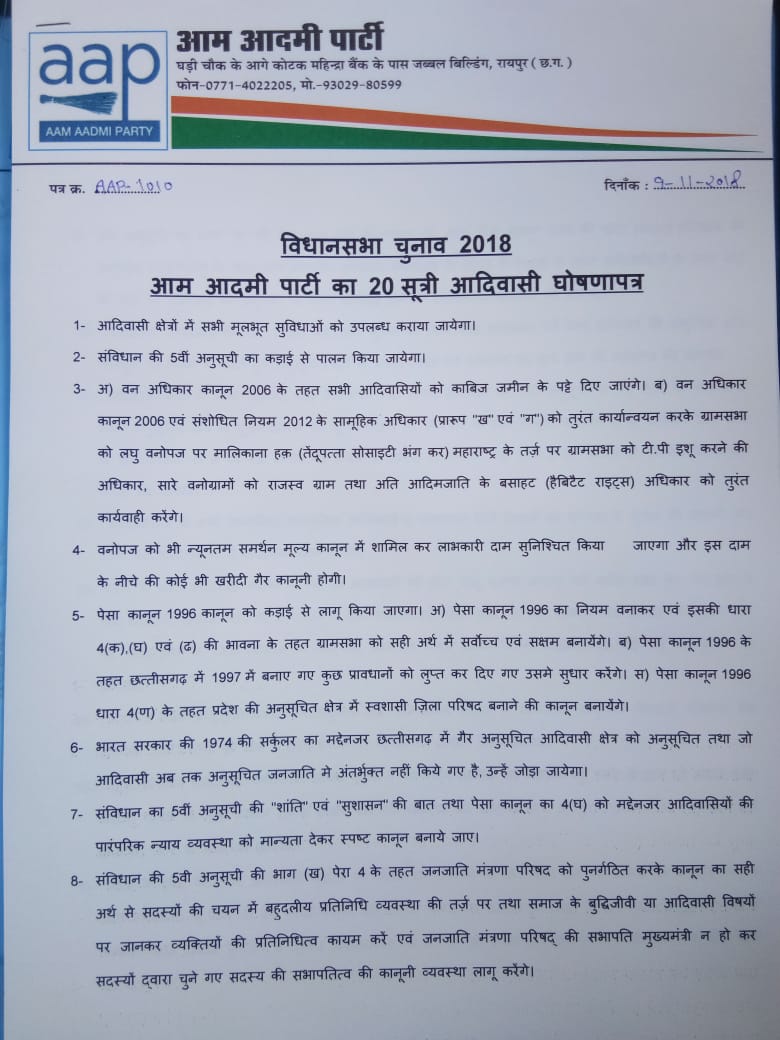BJP, Congress, Aam Aadmi Party, Janata Congress Chhattisgarh have released their manifestos. Taking a look at each party’s manifesto, it becomes clear as to who the party is trying to woo, which community it has neglected and how false its promises are.

In the race for Chhattisgarh’s assembly elections and power over the most resource-rich state, all major and minor political parties released their manifestos before the first phase of the elections. BJP, Congress, Aam Aadmi Party, Janata Congress Chhattisgarh (JCC (J) led by Ajit Jogi, who is in alliance with BSP and CPI, have all come out with their manifestos.
The first phase of polling was scheduled for 18 seats on Nov 12 and voting for the remaining 72 seats will happen on Nov 20.
Taking a look at each party’s manifesto, it becomes clear as to who the party is trying to woo, which community it has neglected and how false its promises are.
BJP party’s ‘Sankalp Patra’
BJP brought out a very colourful and digitally appealing manifesto called ‘Sankalp Patra’ which had every typical promise made by a party and then some. Many saw the manifesto as a gimmick to show that BJP wanted to come to power for the first time in the state. Chhattisgarh has been a BJP ruled state for 15 years.
Besides promising housing, hospitals, education grants, bicycles, etc, the BJP manifesto promised to end Naxalism in the state. In PM Modi’s speeches in Jagdalpur, he said that the issue of Maoism and Naxalism had been eliminated. He must have forgotten that there was a Naxal attack on security forces right before his visit. There was a life-threatening attack on Doordarshan journalists in the state where one cameraperson lost his life. Naxal and Maoist violence has only increased during BJP’s term in the last 15 years.
The manifesto spoke about building a film city to encourage cinema in the state and a microblogging site for the people of Chhattisgarh who are now settled abroad. A report by Sabrang India had observed how many Adivasi and tribal villages in the state had no roads, drinking water or electricity. They did not even know who their CM, PM or area MLA or MP were. There were no schools or hospitals in the area. How does BJP, which has had power for 15 years, plan to highlight the plight of these people on this microblogging site?
In the Election Watch series for Chhatisgarh, Sabrang India had reported how this year, the Modi government had made significant cuts to the support prices of small forest produce. They justified this by saying that it was a loss-making area and they had to scale down the prices. The Raman govt accepted it silently. It was a huge loss to people whose livelihoods depended on the income from forest produce. The BJP ‘Sankalp Patra’ promises to increase the support price for small forest produce by 1.5 times.


Why is the party behaving like an Amazon sale which hikes the original prices of the product and then discounts them, making the people think they bought it for a discount, only to realize that they bought it at MRP.
The manifesto did not speak about how the party will acquire the land for the tall promises it made. It did not speak about curbing the human rights violations in the state, the forced land grab of coal-rich regions and the murder of countless innocent tribal people by security forces.
Congress party’s ‘Jan Ghoshna Patra’
Party president Rahul Gandhi released the party manifesto for the state last Friday. Three days before the first phase of the election. Besides the typical promises of healthcare and farm loan waivers, it also spoke about raising the minimum support price for crops.
The manifesto had a special focus on women’s rights, safety, commute and police help. It spoke about quality education, free universal healthcare, increasing the income for daily wage workers, a monthly stipend for 10 lakh unemployed youth and more.
It spoke about bringing in special laws for the protection of journalists, lawyers and doctors. He also said that special packages worth Rs. 1 crore will be given to every Naxal affected Panchayat to curb the menace.
Former Chattisgarh CM Ajit Jogi said that this manifesto was a “true copy” of the one he had released on June 6, 2016, when the JCC (J) was formed.
AAP manifesto
AAP had an almost identical manifesto to Congress but differentiated itself with a tribal manifesto. Besides promising the typical farm loan waivers and MSP, Alcohol prohibition in the state and job generation, the 36-point manifesto also had a 20 point tribal manifesto.

The state has almost 32% tribal population and the AAP manifesto seems like the only one with an execution plan for tribal development.



It also spoke about halving electricity bills and bringing quality and subsidised education in the state. Apparently, they released their manifesto on a stamp paper.
It promised to bring Chhattisgarh Jan Lokpal Bill, an anti-graft legislation covering the Chief Minister, ministers, MLAs and all government officers. The manifesto also included an end of raids and Inspector Raj.
The Delhi-based party has fielded candidates in all the 90 assembly seats in the BJP-ruled state. The party has projected its Bhanupratappur assembly seat candidate Komal Hupendi as its chief ministerial candidate.
JCC (J) manifesto
Ajit Jogi released his party manifesto on a stamp paper as well. He challenged the ruling BJP, and the Congress to do the same.
“Jogi said he had released the 14-point manifesto of Janata Congress Chhattisgarh (JCC)(J) on stamp paper and therefore was committed to fulfilling the promises mentioned in it. “If I don’t fulfil promises made in it, I can be sent to jail,” he said in a report.
Jogi’s party is in an alliance with Mayawati-led Bahujan Samaj Party and the CPI. The JCC (J) will contest 55 seats, the BSP 33 and CPI two seats.
Besides the typical promises made by all parties and his, there wasn’t much about tribal or mining communities in the manifesto. He said local youth would be given “cent per cent” reservation in government jobs while 90 per cent of other jobs would be reserved for them.
Most, if not all manifestos, touch upon the basics of election promises with some very colourful and attractive visuals, some a simple 14 points and others flogging a dead horse. With the countless forced land grabs, human rights violations, torture of men and women in custody, police brutality, Naxalism on the rise and lack of basic facilities, the manifestos don’t show much promise of actual change in the welfare of the state.